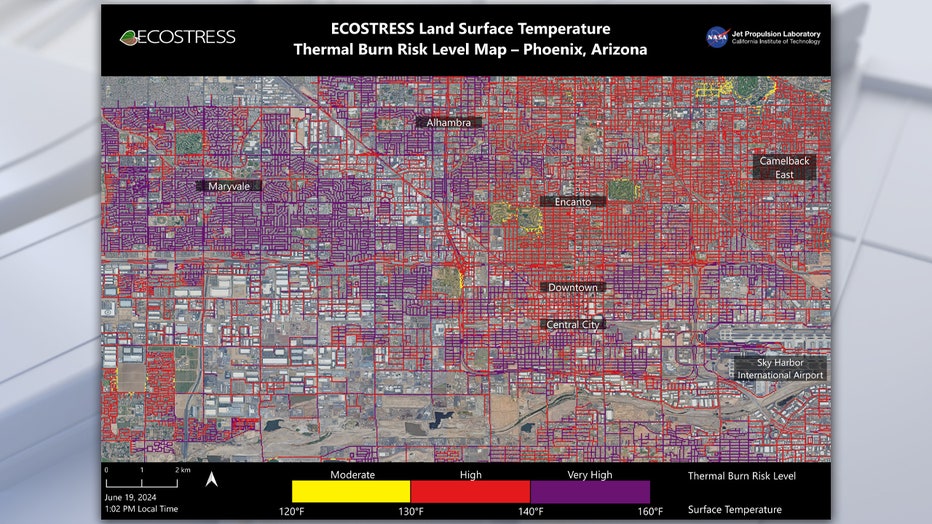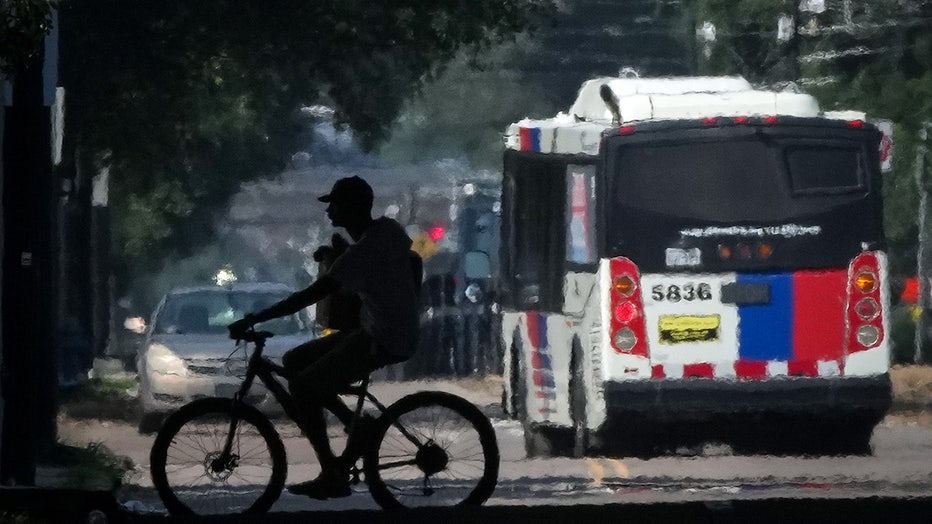From orbit, NASA maps streets where extreme heat will burn you in seconds
PHOENIX - As extreme heat becomes more of a problem across the U.S., NASA is using data from the space station to map out the hottest streets in one major city, where touching pavement could lead to burns in minutes or even seconds.
NASA’s Jet Propulsion Laboratory used the Ecosystem Spaceborne Thermal Radiometer Experiment on Space Station (ECOSTRESS) to collect data from the Phoenix, Arizona area just after 1 p.m. on June 19, 2024. As the official air temperature that day climbed to 106 degrees, the data shows, asphalt and concrete surfaces – which absorb and retain the sun’s heat – ranged from 120 to a scorching 140 degrees.
Burn risk across Phoenix streets
In the color-coded map, the street and sidewalk grid is obvious. The purple-colored lines, of which there are many, show temperatures as high as 140 degrees. That’s hot enough, NASA warns, to cause second-degree burns after only short contact with skin.
The map also shows the cooling effects of parks. The cooler yellow lines, are only seen around the city’s parks and golf courses.

Purple lines show surface temperatures of 140 degrees and higher. (NASA)
LINK: Click for a larger version of the map
"We create these maps to be intuitive to users and help make data more accessible to the public and citizens scientists," said Glynn Hulley, a JPL climate researcher. "We see them as a vital tool for planning effective heat interventions, such as tree planting, that can cool down the hottest roads and sidewalks."
How dangerous is urban heat?
Even though NASA’s map is limited to Phoenix, cities across the U.S. also experience extreme heat during the summer. Temperatures in the 90s – far more common than Arizona’s 100-degree days – can still be dangerous.
Streets are usually the hottest surfaces of the environment due to dark asphalt paving that absorbs more sunlight than lighter-colored surfaces; asphalt absorbs up to 95% of solar radiation. These types of surfaces can easily be 40 to 60 degrees hotter than the air temperature on a very hot day, NASA says.

File: A person rides a bike across Main Street in the afternoon heat Saturday, May 25, 2024, near downtown in Houston. (Jon Shapley/Houston Chronicle via Getty Images)
Who is at risk?
Surface burn victims often include children injured walking barefoot on broiling concrete or touching hot playground surfaces, adults who collapsed on a sidewalk while intoxicated, and older people who fell on the pavement due to heatstroke or another medical emergency.
Bob Woolley, 71, suffered second- and third-degree burns to his hands, arms, leg and torso after he stumbled onto the broiling backyard rock garden at his Phoenix home, wearing only swim trunks and a tank top.
"The ordeal was extremely painful; it was almost unbearable," said Woolley, who was hospitalized at a burn center for several months. He said he considers himself "95% recovered" after extensive skin grafts and physical therapy and has resumed some former activities like swimming and motorcycle riding.

Children play with the water features at a park as southern California faces a heatwave, in Los Angeles, on July 3, 2024. (Photo by ETIENNE LAURENT/AFP via Getty Images)
Playground temperatures
Even playgrounds can be dangerous in the heat, researchers say. The SHaDE Lab, an Arizona State University team that studies the effects of urban heat, found that on a 100-degree day:
- A slide can heat up to 160 degrees (though a covering can bring that down to 111 degrees)
- Rubber ground cover can hit as high as 188 degrees
- A handrail can heat up to 120 degrees
- Concrete can reach 132 degrees
This story was reported from Tampa, Fla. Anita Snow with the Associated Press contributed.

